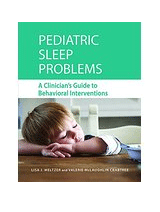“Pediatric Sleep Problems: A Clinician’s Guide to Behavioral Interventions”

“Pediatric Sleep Problems: A Clinician’s Guide to Behavioral Interventions”
By Lisa J. Meltzer and Valerie McLaughlin Crabtree
American Psychological Association
Washington, D.C., 2015
Compelling book offers intervention guidelines
Reviewed by James K. Luiselli, Ed.D., ABPP, BCBA-D
Child and family mental health professionals are frequently consulted to treat pediatric sleep problems. Children who sleep poorly often experience difficulties at school, have health concerns and create family stress. In some cases, a child’s sleep problem may result from psychiatric, neurodevelopmental, and medical conditions.
he good news is that behavioral interventions, specifically applied behavior analysis and cognitive behavioral therapy, are extremely effective in solving pediatric sleep problems. This book by psychologists Lisa J. Meltzer and Valerie McLaughlin Crabtree explains how to perform behavioral sleep assessment and intervention with infants, toddlers, children and adolescents. It is first-rate and a welcome addition to the professional literature.
he authors advise that “with a little practice, and the right tools, any clinician can provide behavioral interventions for common sleep problems.” This practical focus is a highlight of the book, represented by the most contemporary and empirically supported treatments. Chief among many practice objectives, clinicians are guided to select intervention procedures “they are most likely to use in everyday practice and providing a tailored treatment plan for each individual patient.”
he book begins with the basics of pediatric sleep, including sleep architecture, models of sleep regulation, developmental sleep patterns and characteristics of healthy sleep hygiene. This is vital information because most non-medically trained clinicians are unfamiliar with the underlying constructs of normative sleep and deviations that contribute to sleep problems.
Among common sleeping difficulties, the book first considers disorders with a medical basis such as obstructive sleep apnea, restless-legs syndrome, narcolepsy, and sleep-related rhythmic movement disorder. Outside medical-based sleep disorders, chapters address just about every type of behavioral sleep problem, notably delayed sleep-onset, nighttime awakening, bedtime resistance, night fears, insomnia, sleep terrors, nocturnal enuresis, and circadian sleep-wake disturbance.
In a chapter titled “Clinical Assessment of Sleep,” the authors detail the steps for conducting interviews with children and parents, taking a sleep history, screening for sleep disorders and obtaining developmental, psychiatric and medical histories.
Recent advances in measurement technology also enable clinicians to consider sleep assessment through actigraphy (movement detection) and nocturnal polysomnography. As the book makes clear, sleep assessment should include multiple measures for diagnostic, problem identification, and treatment evaluation purposes.
The presentation of specific behavioral interventions is arranged by sleep problems usually encountered with children at different age groups. For each problem, the authors review relevant treatment research, concepts behind the treatments, and intervention procedural guidelines. This material is laid out in a step-by-step format, easy to understand, and illustrated by case examples.
Clinicians will find most appealing the book’s 32 informational handouts for children and parents, freely available from an online link. The handouts summarize most of the behavioral interventions described in the book, condensed onto single pages, with additional guidance tips. There are also various recording forms and examples of visual data analysis.
This is a compelling book that offers clinicians the most complete behavioral intervention guidelines for pediatric sleep problems currently available. The authors were able to translate a vast amount of research into practical application without sacrificing treatment rigor and integrity. The arrangement of chapter by sleep problem also gives clinicians quick access to the most effective treatments.
Meltzer and Crabtree wanted their book “to be a handy and accessible resource that can be used in all types of clinical practice.” That is just what they did, making the book an invaluable guide for ABA and CBT practitioners, as well as multi-disciplinary clinicians seeking the most empirically supported behavioral interventions for children’s sleep problems.
James K. Luiselli, Ed.D., ABPP, BCBA-D, is Chief Clinical Officer, Clinical Solutions, Inc. and North East Educational and Developmental Support Center, Tewksbury, Mass..
Learn more about the book: Pediatric Sleep Problems: A Clinician's Guide to Behavioral Interventions Hardcover May 18, 2015
